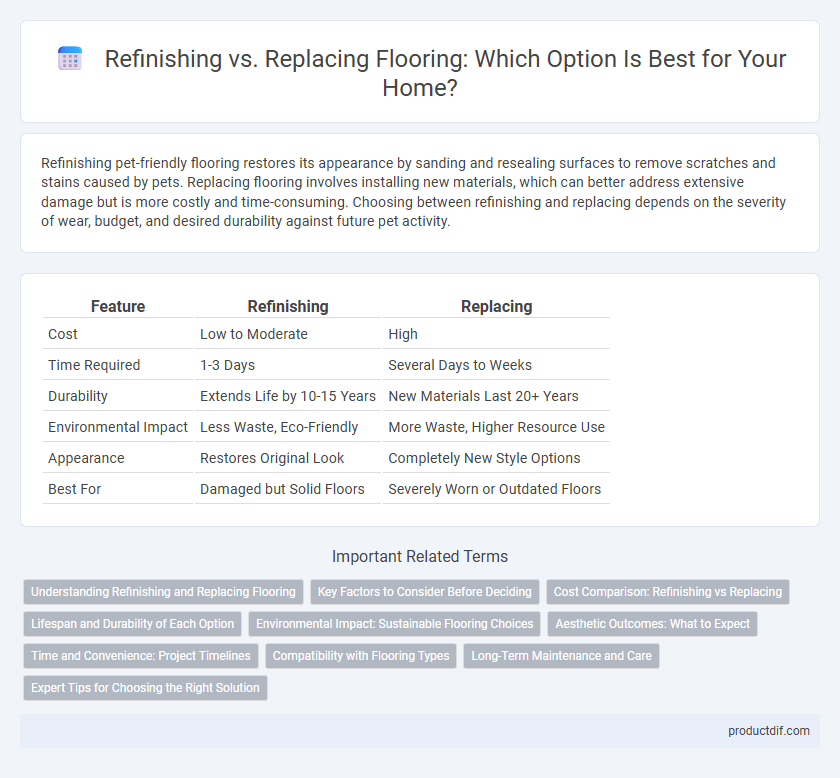Refinishing pet-friendly flooring restores its appearance by sanding and resealing surfaces to remove scratches and stains caused by pets. Replacing flooring involves installing new materials, which can better address extensive damage but is more costly and time-consuming. Choosing between refinishing and replacing depends on the severity of wear, budget, and desired durability against future pet activity.
Table of Comparison
| Feature | Refinishing | Replacing |
|---|---|---|
| Cost | Low to Moderate | High |
| Time Required | 1-3 Days | Several Days to Weeks |
| Durability | Extends Life by 10-15 Years | New Materials Last 20+ Years |
| Environmental Impact | Less Waste, Eco-Friendly | More Waste, Higher Resource Use |
| Appearance | Restores Original Look | Completely New Style Options |
| Best For | Damaged but Solid Floors | Severely Worn or Outdated Floors |
Understanding Refinishing and Replacing Flooring
Refinishing flooring involves sanding down the existing surface to remove scratches and wear, then applying a new stain and protective finish, which preserves the original material and reduces cost and waste. Replacing flooring entails removing old planks or tiles entirely and installing new materials such as hardwood, laminate, or vinyl, offering a complete aesthetic transformation and often solving underlying structural issues. Choosing between refinishing and replacing depends on the flooring type, damage extent, budget constraints, and desired longevity of the floor.
Key Factors to Consider Before Deciding
When choosing between refinishing and replacing flooring, assess the material's current condition, age, and damage severity. Refinishing is cost-effective for hardwood floors with minor scratches or wear, preserving original planks and maintaining value. Replacing is better for floors with extensive damage, outdated styles, or structural issues, offering updated designs and long-term durability.
Cost Comparison: Refinishing vs Replacing
Refinishing hardwood floors typically costs between $3 to $8 per square foot, offering a budget-friendly option compared to replacing, which ranges from $8 to $15 per square foot depending on materials and labor. Refinishing extends the life of existing floors by restoring their appearance, while replacing involves higher expenses for new flooring, subfloor preparation, and installation. Homeowners often choose refinishing for cost savings and faster completion, whereas replacing provides a longer-term upgrade with updated materials.
Lifespan and Durability of Each Option
Refinishing hardwood flooring extends its lifespan by up to 20-30 years, preserving the original material's durability while restoring surface wear and scratches. Replacing flooring with materials like laminate, vinyl, or engineered wood offers longer durability options, with warranties ranging from 15 to 40 years, depending on product quality and installation. Choosing between refinishing and replacing depends on the existing floor's condition and desired longevity, with refinishing maintaining natural hardwood integrity and replacing providing modern material resilience.
Environmental Impact: Sustainable Flooring Choices
Refinishing hardwood floors significantly reduces environmental impact by extending the lifespan of existing materials, minimizing waste and resource consumption. Replacing flooring often involves discarding old materials, increasing landfill contributions, and requiring production of new materials, which elevates carbon emissions and depletes natural resources. Sustainable flooring choices prioritize refinishing when possible, alongside selecting eco-friendly materials like bamboo or reclaimed wood for replacements, to reduce ecological footprint.
Aesthetic Outcomes: What to Expect
Refinishing hardwood flooring restores its natural beauty by sanding away surface imperfections and applying fresh stain or sealant, resulting in a smooth, like-new finish that preserves the original character. Replacing flooring offers the opportunity to completely change the aesthetic, introducing new styles, colors, and materials tailored to current design trends and personal preferences. Expect refinishing to maintain the existing floor's patina and grain patterns, while replacement allows for a full transformation of the room's look and feel.
Time and Convenience: Project Timelines
Refinishing hardwood floors often requires 2-4 days, including sanding, staining, and drying, offering a quicker solution with less disruption. Replacing flooring can take 1-2 weeks due to demolition, subfloor preparation, and installation of new materials. Homeowners seeking minimal downtime typically prefer refinishing for its faster project timeline and convenience.
Compatibility with Flooring Types
Refinishing is ideal for hardwood floors like oak, maple, and cherry, as their solid wood surface allows sanding and recoating without damage. Engineered wood and laminate flooring typically aren't suitable for refinishing due to their thinner wear layers or synthetic composition, necessitating replacement when worn. Tile, vinyl, and carpet require replacement rather than refinishing since they lack the structural properties needed for sanding or recoating.
Long-Term Maintenance and Care
Refinishing hardwood flooring preserves the original wood, providing a cost-effective long-term solution that enhances durability and maintains aesthetic appeal with periodic sanding and sealing. Replacing flooring offers an opportunity to upgrade to more resilient materials like luxury vinyl or engineered wood, which require less frequent maintenance and resist wear better over time. Long-term care for refinished floors involves proper cleaning with pH-neutral products and controlling humidity, while replaced floors may benefit from manufacturer-recommended maintenance to extend lifespan and performance.
Expert Tips for Choosing the Right Solution
Refinishing hardwood floors restores their original beauty by sanding and applying a fresh finish, making it a cost-effective option for floors with minimal damage. Replacing flooring is recommended when boards are severely warped, cracked, or water-damaged, ensuring long-term durability and aesthetic appeal. Experts advise evaluating factors like the extent of wear, budget, and desired style to choose between refinishing and replacement effectively.
Refinishing vs Replacing Infographic

 productdif.com
productdif.com